Made By:
Johnny Lightning
Scale:
1/24
MSRP:
US$12.95
| Overview: | |
|---|---|
| Packaging (Design): | 9/10 |
| Packaging (Durability): | 9/10 |
| Casting (Body): | 10/10 |
| Casting (Interior): | 10/10 |
| Casting (Chassis): | 8/10 |
| Casting (Engine): | 8/10 |
| Paint (Exterior): | 10/10 |
| Paint (Interior): | 10/10 |
| Paint (Trim/Graphics): | 8/10 |
| Overall Panel Fit: | 8/10 |
| Total Score: | 9.0/10 |

Other Factory Stock Models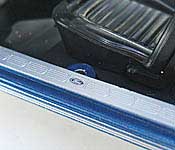
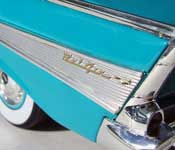

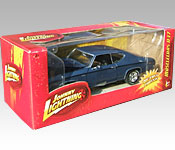
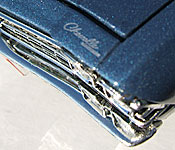
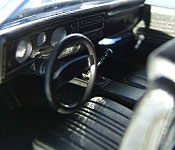
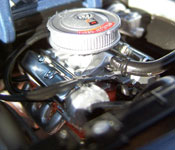
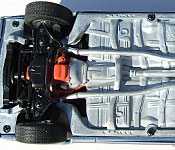
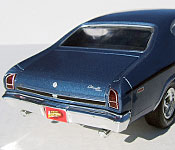
Packaging
Johnny Lightning's box has been updated for this release with the JL logos in the top left and bottom left corners of the top and front panels (respectively), solid end flaps with the JL logo centered on each, and "Musclecars R37" and the enclosed model written vertically up the right edge of the front panel. "Die Cast Chassis" is in a star burst near the bottom right corner of this panel. The back of the box has the scale, JL logo, web contact information, and a checklist of the cars in the recent series. The bottom of the box retains the window allowing you to view the chassis, along with the bar code and the rest of the legal information. The car is held in place thanks to a simple tray at each end of the box, making it easy to remove and replace as desired. A plastic band holds the doors closed.
Casting/Paint
As usual, Johnny Lightning's casting work is excellent. With sharp contours and a well-sculpted panels, the first impression is that of a much more expensive replica. The paint further enhances this with a smooth, glossy blue that includes the door frames and underside of the hood. Bright chrome-plated plastic is used for the bumpers, grille, hood vents, side mirror, door handles, and exhaust tips. Silver paint is used for the rest of the trim, including the windshield and rear window surrounds, locks, drip rails, wheel arches, and tail light frames. These don't quite line up correctly: the driver's side drip rail bleeds onto the roof, the wheel arches are faded in places, and the door locks are too far forward on both sides. The "Chevelle" and "SS" scripts, side marker lights, side stripes, and trunk panel are printed onto the body flawlessly, with the nose and tail scripts looking particularly nice (you can almost make out "by Chevrolet" under the Chevelle badge). Headlights, windshield, rear side windows, and rear window are clear plastic, and the tail lights are transparent red. The tires are vinyl with "Good Year/Polyglas GT - F60 - 15" printed neatly on the sidewalls and bright chrome plastic 5-spoke wheels. The chassis is JL's usual "raw metal" with black front suspension components...part of me wishes that they would drop this idea and start painting the underside of the car, but the sculpting work is so good that I don't really mind (and if saving that paint application saves them enough money to add extra detail elsewhere, then all the better). The 396 looks great, and is painted all the way around, including the bits that are part of the chassis. Orange is the base color, with black paint on the starter and silver paint on the alternator, intake, and exhaust manifolds. The air cleaner is either painted silver or cast in silvery-gray plastic with the "396/Turbo-Jet 375HP" decal along the leading edge. The radiator, belt assembly, radiator hoses (yes, they included both), heater hoses, carburetor, and ignition wires are all black. The latter still suffers from the usual split-down-the-middle "Alfalfa" look, but thanks to Chevrolet locating the distributor at the back of the engine this is almost entirely hidden by the air cleaner. Most of the surrounding engine bay is painted black, except for the walls directly above the inner fenders: these are unpainted metal. The interior is pretty much solid black, with nice detail work, painted (but not detailed) gauge faces, a chrome shift lever with a black-painted knob, chrome door sills, and a chrome rearview mirror.
Features/Accessories
The hood and doors open, and the front wheels can be posed. The hood doesn't quite seem to close flush with the fenders, but the doors seat as they should.
Accuracy
The only oddity I see here is that the front of the car seems to be too high, as if too-stiff front springs had been installed. Otherwise it looks great. The paint looks like a very close match to the Code-51 Dark Blue Metallic with the black SS stripe option. The black wash on the grille looks very nice, but is, unfortunately, incorrect: these cars generally had black-painted grilles, while the silver was reserved for the non-SS models. Scaling is a good 1/24.
Overall
The 1:1 Chevelle is an undeniable classic, and Johnny Lightning has captured it beautifully. The few nitpicks really only stand out because of the rest of the car is so good. You won't find a better '69 SS in the sub-$100 range without building it yourself. Very highly recommended.
Send me an e-mail with your thoughts!